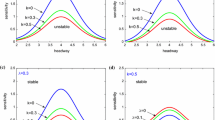Abstract
In this paper, a car following model is built on observations and analysis of human driver behaviour. This model considers both the gap distance and the speed difference between two vehicles, and determines when and how a driver accelerates (decelerates). The simulation result shows that the probability distributions for both speed differences and time headways match the data from observation. In addition, some theoretical analysis are given to verify this model. The distribution of time headways is consistent with the empirical conclusion; and a stochastic differential equation summarized from the model represents the interdependence of gap distance and speed difference. The model is simple to understand and is an improvement on former work.
Similar content being viewed by others
References
D.C. Gazis, R. Herman, R.W. Rothery, Operation Research 7, 499 (1959)
R. Barlovic, L. Santen, A. Schadschneider, M. Schreckenberg, Eur. Phys. J. B 5, 793 (1998)
D. Chowdhury, L. Santen, A. Schadschneider, Phys. Rep. 329, 199 (2000)
B.S. Kerner, S.L. Klenov, J. Phys. A: Math. Gen. 39, 1775 (2006)
J. Olstam, A. TApani, Swedish National Road and Transport Research Institute VTI meddelande 960A, 2004
R.E. Chandler, R. Herman, E.W. Montroll, Oper. Res. 6, 165 (1958)
M. Bando, K. Hasebe, A. Nakayama, A. Shibata, Y. Sugiyama, Phys. Rev. E 51, 1035 (1995)
R.M. Michaels, in Proceedings of the 13th International Symposium on Traffic and Transportation Theory (1963), p. 349
D. Lamble, M. Laakso, H. Summala, Ergonomics, 42, 807 (1999)
T. Sato, M. Akamatsu, Transp. Res. Pt. F 10, 397 (2007)
M. Miska, T. Muller, J. van Zuylen, in 9th International IEEE Conference on Intelligent Transportation System (2006), p. 1609
T. Toledo, Ph.D. thesis, Massachusetts Institute of Technology, 2003
P. Wagner, Eur. Phys. J. B. 52, 427 (2006)
M. Brackstone, M. McDonald, Transp. Res. Pt. F 2, 181 (1999)
W. Van Winsum, A. Heino, Ergonomics 39, 579 (1996)
W. Van Winsum, W.H. Brouwer, Percept. Mot. Skills 84, 1247 (1997)
Y. Wei et al., in 10th International IEEE Conference on Intelligent Transportation System (2007), pp. 167–172
J.C. Hayward, The Pennsylvania State University, Report No. TTSC 7115, 1972
R. Luttinen, Ph.D. thesis, University of Techonology Lahti Center, 1996
G. Zhang, Transp. Res. Rec. 1999, 141 (2007)
H. Risken, The Fokker-Planck equation, 2nd edn. (Springer-Verlag, 1989)
Author information
Authors and Affiliations
Corresponding author
Rights and permissions
About this article
Cite this article
Wang, L., Zhang, H., Meng, H. et al. A model based on TTC to describe how drivers controltheir vehicles. Eur. Phys. J. B 66, 149–153 (2008). https://doi.org/10.1140/epjb/e2008-00389-0
Received:
Revised:
Published:
Issue Date:
DOI: https://doi.org/10.1140/epjb/e2008-00389-0




